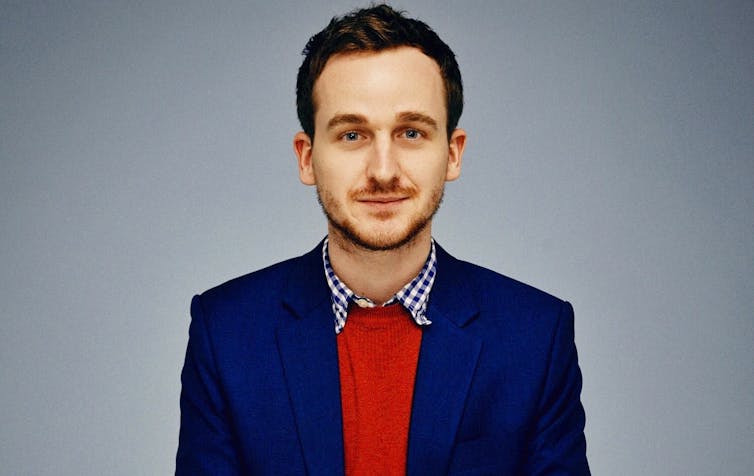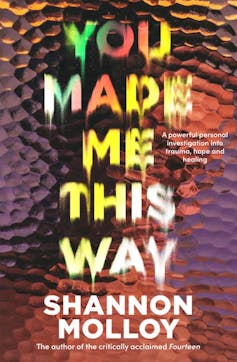
Daryl Higgins, Australian Catholic University
Journalist Shannon Molloy is used to sharing his story. In his 2020 memoir, Fourteen (now adapted for the stage), he wrote about growing up gay in regional Queensland in the 1990s, enduring severe bullying.
He wrote in a piece that sparked the memoir:
I was bashed, ridiculed, taunted endlessly, you name it. I was almost run over. At a school camp, I was tied to a tree and beaten with an oar. Teachers seemed indifferent. Some blamed my “personality”. I lived in despair, although in hindsight, it’s clear I wasn’t really living at all.
Book review: You Made Me This Way – Shannon Molloy (HarperCollins)
But despite having shared his childhood despair, he’s been a man with a secret. A secret most men wouldn’t talk about: his experience of being sexually abused as a child, from the age of five.
What made it especially challenging to talk about was that it happened not at the hands of an adult, but another child, who was only three years older than him.

Not just another trauma memoir
This memoir-turned-case-study, turned-research-exploration, is a fascinating read. It’s filled with horror, secrecy and shame, but it’s also tempered with hope, insight and healing.
It stands out within the growing genre of “trauma memoirs”. Molloy uses his personal journey, peppered throughout with case-study vignettes from men he has interviewed about their own experiences of childhood sexual abuse, to illustrate what we know from research and clinical practice.
I’m not usually a fan of biographies, or memoirs. I love fiction, but I’m also a scientist at heart. Even when it comes to understanding the lived experience of victims of violence, abuse or bigotry, I encounter personal stories through my daily work as a researcher. I prefer to avoid the slow and messy reveal of a person’s memoir.
But Molloy invites us into his experience, and I was hooked.
He discloses his experience of being abused by “Joshua”, a slightly older boy, in the book’s first five pages. With that disclosure out of the way, he embarks on a much bigger journey: to make sense of what that experience is, what it has meant for him, why he is the way he is, and his subsequent search for “peace”.
A consistent theme is secrecy, and the urgency of the task of revealing.
These are the secrets I’ve carried with me since I was five. Things I thought I’d never dare to tell anyone for fear they wouldn’t understand.
Challenging questions
Molloy uses this format to explore some big and challenging questions, such as whether the experience of harmful, unwanted sexual contact from another child or young person “counts” as sexual abuse.

At what point does sexual play and natural, typical developmental exploration become problematic? Or harmful? Or abuse? What happens if there are parts of what’s happening that you at some level enjoy? Molloy asks: compared to survivors of sexual abuse at the hands of an adult perpetrator, am I a fraud? An impostor?
He invites us to see and feel it from his five-year-old perspective. And he invites us to share the reality for adult victims of child sexual abuse — particularly men – of feeling “alone”, the constant worry of others finding out, of being blamed.
But he also intersperses interviews and discussions with some key researchers, and service providers who work with child sexual abuse, including children who have experienced sexually harmful behaviours from other children or youths.
Researchers’ insights
Carol Ronken is research mananger of Bravehearts, one of only a few services in Australia with a dedicated program, Turning Corners, that works with young people who have engaged in or are at risk of engaging in harmful sexual behaviour.
Around one-third of child sexual abuse cases are instigated by another young person, she told a shocked Molloy.
And while the risk of sexual abuse is greater for girls than boys, the gap between them is closer for some of its more severe forms. (The gap was almost 15 percentage points for sexual abuse overall, but for penetrative sexual abuse, it was just five points.) The data we need to paint a more accurate picture is coming soon.
We meet UNSW Professor Michael Salter, one of Australia’s leading child abuse researchers, who advocates for better responses for victims of child sexual abuse. Salter confirms Molloy is not alone in delaying disclosure; most victim/survivors delay it. And, like Molloy, most don’t report to police, and they feel shame, feel responsible, and “can’t rely on support or understanding should they speak up and ask for help”.
Molloy reflects on research findings about the links between child sexual abuse, mental health, and risk of re-victimisation later in life. He cites a 2010 study that showed child sexual abuse victims were three-and-a-half times more likely than the general population to access mental health services during their lives.
He also points to the challenges of delivering trauma-informed mental health treatment, and coordinating care across the system. A recent inquiry in Victoria revealed a system that is “overwhelmed” and can’t keep up with the need for treatment, care and support close to where people live.
Molloy brings us with him as he works through the issues, realising how elements of his experience align with so many stories of survivors of child sexual abuse: the reality of the power imbalance between a perpetrator and victim; the absence of consent; and the use of manipulation, threats (“don’t tell anyone”) or coercion (even “gentle coercion”, as he beautifully describes the process of what we now know as “grooming”).
One of the men he interviewed, Will, said:
He showered me with attention and gifts, but there was a price. There was always a price.
Irreparably ‘broken’?
But with all Molloy’s reporting and analysis, his personal story is of someone who thinks it is his fault. Who thinks he is somehow responsible – and therefore is in some way fundamentally, irreparably “broken”.
I imagine sometimes what kind of man I would be if I’d never met Joshua. If our paths had never crossed and we’d never been friends, and he’d never touched me that way in his bedroom, and all of those other times hadn’t followed, who might Shannon Molloy be?
The characteristics typical of child sexual abuse, particularly for men, are all there. The shame, the secrecy. And the overlay of homophobia (and self-loathing) when the harm occurs from someone of the same sex as you.
What is surprising – and evidence of the arduous and meticulous journey of self-discovery on which he embarked – is the length to which Molloy has gone to put himself in the shoes of the older boy at whose hands he suffered.
He tries to understand what might have influenced him to behave the way he did, and where it might leave him, as an adult with that past. He asks: is the older boy, Joshua, the villain in his story?
Legal horrors
His stories from other men illustrate the horror of the legal tactics defence lawyers use in child sexual abuse criminal matters. To discredit victims, lawyers bring up sordid details of things the victims had fallen into “for comfort, as a crutch, as some kind of validation, or merely as a result of the pain”.
Rather than tell their own story within its full context, they are forced to answer specific questions about specific details, with any inconsistencies creating doubt in the minds of jurors. Such tactics have been seen on stage in lawyer-turned-playwright Susie Miller’s show, Prima Facie, a searing indictment of how the legal system continues to fail victims and survivors of sexual assault.
Molloy shows how inadequate and broken our criminal justice systems are. But victims must rely on them until we as a society are prepared to do the hard yards and find innovative mechanisms for achieving recognition and justice for victim/survivors of any form of sexual victimisation:
Innovative responses are a variety of newer practices that seek to address victims’ justice needs, including an acknowledgment of wrongdoing and mechanisms of redress or repair. They may be part of the criminal justice system, work alongside of it, or be independent of it. Innovative responses assume a mixed model of reliance on formal legal mechanisms, informal justice interactions, and civil society practices, with an emphasis on victim participation, voice, validation, and vindication, and on offender accountability.
A gaping hole in knowledge
Molloy reveals a gaping hole in our picture of child sexual abuse and its impact. We need better knowledge about the dynamics, the frequency, the impacts and the approaches to prevention, therapy and justice, when the victim is male, but also when the harm is not from an adult, but another child or young person.
He calls us to “open our eyes”, to “pledge not to look away” from the issue, despite the challenges. His message is to empower and believe children, to radically reform our judicial system’s reliance on the adversarial system for handling child sexual abuse matters, and to rethink mental health services for victim/survivors.
But most importantly, he illustrates that experiences of child sexual abuse, including harmful behaviours from other children and young people, are not a life sentence. The hard part is speaking up – asking for help. Especially for men. Molloy’s memoir shows us how this can be done.
In his own closing words: “Thanks for not looking away.”![]()
Daryl Higgins, Professor & Director, Institute of Child Protection Studies, Australian Catholic University
This article is republished from The Conversation under a Creative Commons license. Read the original article.

